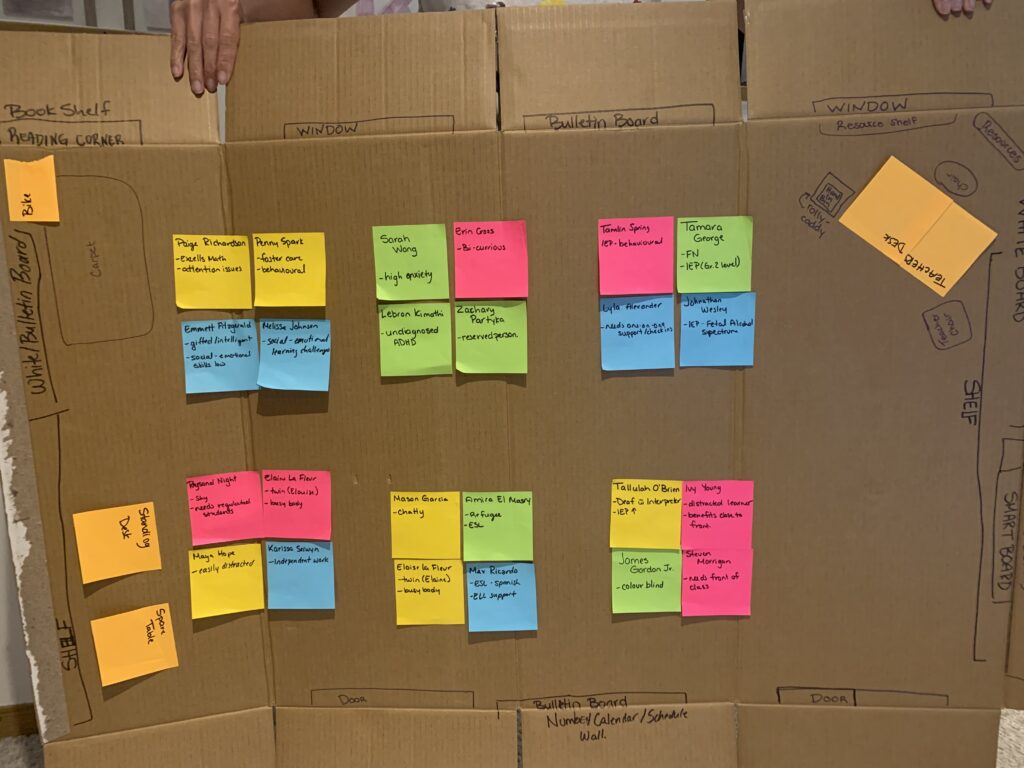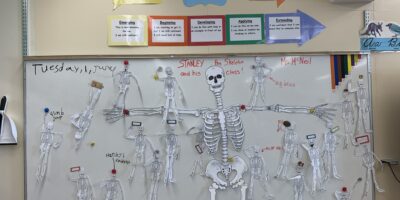*Credit to my Educ 402 reading group for co-creating this classroom for our imaginary diverse learners*
1. Knowing what you know about your learners, now, and also what you know about yourself, design the classroom space to fit all needs (including yours). This should include
a. table/desk placement, groupings→ refer to attached picture of layout
b. material placement – Each student would have a book bin, coloured duotangs for lessons (ex. Writing journal), binder for core lessons work, pencil case with essentials (in desk).
- Submit to hand in bin, in front of class by teachers desk
- Math manipulative in clean bins on the back shelf, teachers personal book collection in reading corner, front shelf will hold all subject duotangs, caddy with colouring sheets, extra paper etc.. Students are responsible for their own supplies, if using resources from the class set, students are responsible for caring for it and cleaning up after themselves.
- Reading corner, calm down corner with bike and soft manipulatives, daily 5 station, number corner/schedule/ calendar wall station. Spare table for different working zone/ small groups, and standing table
- Word wall, FPPL poster, 7 sacred teachings, Core curricular competencies, Big Ideas/objectives, classroom jobs, student display board (for work), triple scoop, posters with colours in Dakelh and French, ASL posters (colours, common words, alphabet)
- Smart Board, Ipads (Daily 5, ESL students, reading), mobile computer lab (when needed)
c. where is your teacher space? Why is it located where it is?
- Desk in front corner of the classroom. Located near students that need continuous or higher levels of support. Also then the students are able to glance up and see the teacher. Desk and caddy are also easily accessible when you walk into the classroom and the teacher keeps things in close proximity to them while they are teaching at the front.
d. how do you plan for learners to enter and exit the room? Think about flow of movement.
- There are two doors located in the classroom. One is for entering, one is for exiting. This allows for students, parents and other teachers to be able to enter and exit without running into other people. This also gives a designated spot for students to line up at when transitioning in and out of the classroom. Two doors also let students socially distance due to covid regulations and health reasons.
2. Using planning resources in our class resource folder, or from other lived experiences, plan your community building activities that elicit student voice and agency, and that target:
a. expected behaviours – both educator and learner
- Learner: think-pair-share: class rules and expectation, classroom contract= poster on the wall
- Educator: Same activity: teacher expectations, teacher philosophy/pedagogy posted behind desk to refer too
b. conflict resolution policies in learning space
- W.I.T.S poster and conversation, acting out/discussing situations (related to social-emotional learning), RRP Cards, Restorative Questions, Zones of regulation
c. use of technology
- Use of smart board, no phones, use of Ipads and mobile lab
- Adding technology to certain lessons
- Scratch (coding), Kahoot (create own for class), Class Dojo
- Adding technology to certain lessons
3. Lastly, create a clear plan to communicate to me how you, as educator, will be managing the day-to-day learning and energy of the individuals in the room. What are the routineized practices in the classroom that learners can rely on? How will these help learners regulate themselves in order to be ready to learn?
Morning:
- Soft start: Students hang up their backpacks and jackets, put on shoes, get ready for morning meetings (student check in’s) → Morning calendar and shape of the day (highlighting important events),
- morning work (journal or Daily 5).
Recess
Mid-morning:
- Instruction time → longer lessons because it is normally the best teaching/learning time or multi-lessons
Lunch
Outside time
Afternoon
- Instructional/ hands on learning/ out of class instruction etc.
End of Day
- Classroom clean up (class jobs), important notices for next day, final moments to gather books, check-out (like a check in but end of day version), backpacks and jackets, dismissal
Routine/attention grabbers
- Quiet coyote
- ASL (taught to students, front loading)
- Finish the lyric (Front load)
- Point in directions, end with both hands up
- Tuning fork/wand
- Meditation bowl (ding/vibration bowl and hum along)
- Chimes
- Forever lineup- permanent line up that never changes
- VIP/calendar helper
- Fidget toy/ standing desk for when needed
Note: This is the link to our co-created/ collaborated Pinterest board
- It visually shows our ideal classrooms, with layout, posters, bulletin boards etc.
- https://www.pinterest.ca/hannahtrombley/classroom-design/




Leave a Reply